Shinta Mani Mustang
Nepal














THE PERSONALITIES
Adventurers. Pilgrims. Story seekers. Cultural wanderers. Mountain dreamers.
THE MOMENTS
Sunrise over snow-capped peaks. Ancient monasteries perched on cliffs. Prayer flags dancing in Himalayan winds. A firelit evening wrapped in yak wool blankets. Nights under endless stars.
BEST VISITING MONTHS
March to May and September to November are the best months to visit Mustang, Nepal, when skies are clear, trails are open, and the Himalayas unveil their full glory. Spring brings rhododendron blooms and lush valleys, while autumn offers crisp air, golden landscapes, and perfect trekking conditions.















WHY STAY
Tucked in the remote Mustang region of Nepal, Shinta Mani Mustang overlooks one of the most dramatic landscapes on earth — the snow-dusted peaks of the Annapurnas and the Kali Gandaki River Valley. Once a forbidden kingdom, Mustang remains a rare portal into an ancient world where geography, culture, and spirituality remain intertwined.
The resort, designed by visionary architect Bill Bensley, blends raw Himalayan textures with refined comfort. Local stone, wood, and textiles shape spaces that feel both timeless and rooted in place. Its 29 suites frame sweeping mountain views, each crafted as a sanctuary for reflection after days of exploring the rugged trails and monasteries nearby.
Beyond design, Shinta Mani Mustang is a story of legacy. Its creation honors Mustang’s centuries-old culture while introducing a new chapter in hospitality — one where comfort and conscience coexist. Every stay is a passage into the soul of Mustang, balancing luxury with respect for the land and its people.









WHY WANDER
Wandering here is not just about place, but about time. Ancient Buddhist monasteries, some carved into cliffs, still hum with prayer and ceremony. Pilgrimage routes wind through villages unchanged for centuries, where traditions remain vibrantly alive.
Adventure is endless — from high-altitude treks across desert-like valleys to horseback journeys along Himalayan trails. Days unfold among canyons, caves, and sweeping ridges that feel more like Mars than Earth, yet are deeply human in their history and lore.
The spirit of Mustang lies in its remoteness. Few regions allow travelers to touch the Himalayas so intimately — through sacred festivals, timeless rituals, and landscapes that challenge perspective. Wandering here is to step into a living heritage, guided by monks, herders, and mountain winds.
INDULGE IN
The cuisine at Shinta Mani Mustang draws from Nepalese tradition while weaving in global influences. Locally sourced ingredients — lentils, grains, seasonal vegetables, yak dairy — form hearty dishes made to nourish after long days of exploration. Dining here is an extension of the land: warm, grounding, and deeply tied to Himalayan flavors.
GETTING THERE
Reaching Shinta Mani Mustang is a journey in itself. Guests typically fly into Kathmandu, followed by a domestic flight to Pokhara, and then on to Jomsom, the gateway to Mustang. From there, the resort is a short drive away — each leg of the trip a gradual immersion into higher altitudes and deeper remoteness.













WILD INITIATIVES
Shinta Mani Mustang is built on a philosophy of giving back — a hotel where luxury is inseparable from responsibility. At its core is the Shinta Mani Foundation, an initiative that has transformed lives across Asia by supporting education, healthcare, and skills training. In Mustang, this means empowering local communities through employment, vocational opportunities, and cultural preservation, ensuring that tourism enriches rather than erodes.
Environmental stewardship is equally vital. The resort is designed to minimize impact on this fragile high-altitude ecosystem, from waste management and renewable practices to careful sourcing of water and materials. Local artisans and builders were integral to the construction, ensuring that the architecture reflects Mustang’s heritage while supporting regional economies.
Every stay directly contributes to regenerative travel: protecting sacred landscapes, sustaining traditional crafts, and helping preserve the spiritual and cultural legacy of Mustang. Guests become part of a wider movement — one that doesn’t just explore the Himalayas but actively safeguards them for generations to come.
Photos by Elise Hassey, Shinta Mani Mustang








